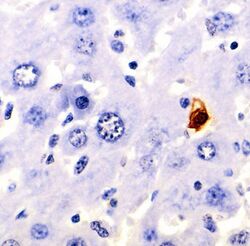Biology:TUNEL assay
Terminal deoxynucleotidyl transferase dUTP nick end labeling (TUNEL) is a method for detecting DNA fragmentation by labeling the 3′- hydroxyl termini in the double-strand DNA breaks generated during apoptosis.[1][2]
Method
TUNEL is a method for detecting apoptotic DNA fragmentation, widely used to identify and quantify apoptotic cells, or to detect excessive DNA breakage in individual cells.[3] The assay relies on the use of terminal deoxynucleotidyl transferase (TdT), an enzyme that catalyzes attachment of deoxynucleotides, tagged with a fluorochrome or another marker, to 3'-hydroxyl termini of DNA double strand breaks. It may also label cells having DNA damage by other means than in the course of apoptosis.
History
The fluorochrome-based TUNEL assay applicable for flow cytometry, combining the detection of DNA strand breaks with respect to the cell cycle-phase position, was originally developed by Gorczyca et al.[4] Concurrently, the avidin-peroxidase labeling assay applicable for light absorption microscope was described by Gavrieli et al.[5] Since 1992 the TUNEL has become one of the main methods for detecting apoptotic programmed cell death.[6] However, for years there has been a debate about its accuracy, due to problems in the original assay which caused necrotic cells to be inappropriately labeled as apoptotic.[7] The method has subsequently been improved dramatically and if performed correctly should only identify cells in the last phase of apoptosis.[8][9] New methods incorporate the dUTPs modified by fluorophores or haptens, including biotin or bromine, which can be detected directly in the case of a fluorescently-modified nucleotide (i.e., fluorescein-dUTP), or indirectly with streptavidin or antibodies, if biotin-dUTP or BrdUTP are used, respectively. The most sensitive of them is the method utilizing incorporation of BrdUTP by TdT followed by immunocytochemical detection of BrdU.[10]
References
- ↑ "Presence of DNA strand breaks and increased sensitivity of DNA in situ to denaturation in abnormal human sperm cells. Analogy to apoptosis of somatic cells". Exp Cell Res 207 (1): 202–205. 1993. doi:10.1006/excr.1993.1182. PMID 8391465.
- ↑ "Density gradient capacitation is the most suitable method to improve fertilization and to reduce DNA fragmentation positive spermatozoa of infertile men". Anatolian Journal of Obstetrics & Gynecology 3 (1): 1–7. 2009. https://www.researchgate.net/publication/259983025.
- ↑ "Relationship between Caspase Activity and Apoptotic Markers in Human Sperm in Response to Hydrogen Peroxide and Progesterone". Journal of Reproduction and Development 55 (6): 615–621. 2009. doi:10.1262/jrd.20250. PMID 19734695.
- ↑ "DNA strand breaks occurring during apoptosis: Their early in situ detection by the terminal deoxynucleotidyl transferase and nick translation assays and prevention by serine protease inhibitors.". International Journal of Oncology 1 (6): 639–648. 1992. doi:10.3892/ijo.1.6.639. PMID 21584593.
- ↑ Gavrieli Y, Sherman Y, Ben-Sasson SA (1992). "Identification of programmed cell death in situ via specific labeling of nuclear DNA fragmentation". J. Cell Biol. 119 (3): 493–501. doi:10.1083/jcb.119.3.493. PMID 1400587.
- ↑ "Analysis of apoptosis by cytometry using TUNEL assay". Methods 44 (3): 250–254. 2008. doi:10.1016/j.ymeth.2007.11.008. PMID 18314056.
- ↑ "In situ detection of fragmented DNA (TUNEL assay) fails to discriminate among apoptosis, necrosis, and autolytic cell death: a cautionary note". Hepatology 21 (5): 1465–8. 1995. doi:10.1002/hep.1840210534. PMID 7737654.
- ↑ "In situ apoptotic cell labeling by the TUNEL method: improvement and evaluation on cell preparations". J Histochem Cytochem 44 (9): 959–68. 1996. doi:10.1177/44.9.8773561. PMID 8773561.
- ↑ "Importance of DNA fragmentation in apoptosis with regard to TUNEL specificity". Biomed Pharmacother 52 (6): 252–8. 1998. doi:10.1016/S0753-3322(98)80010-3. PMID 9755824.
- ↑ "Labeling DNA strand breaks with BrdUTP. Detection of apoptosis and cell proliferation". Cell Proliferation 28 (11): 571–579. 1995. doi:10.1111/j.1365-2184.1995.tb00045.x. PMID 8555370.
External links
- TUNEL at the US National Library of Medicine Medical Subject Headings (MeSH)
 |


